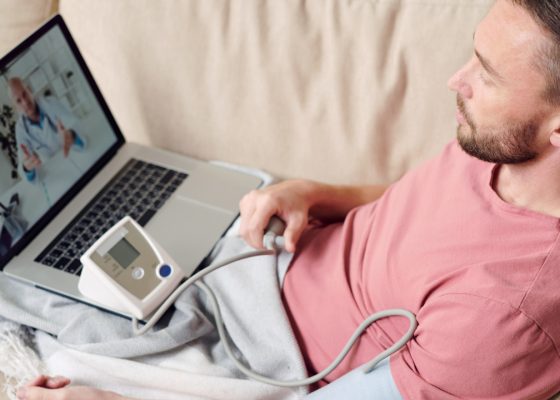We are using the very virtual care tools designed to support us, to instead compete with and hollow out our own services.
Virtual care isn’t a substitute — it’s an adjunct.
Used wisely, it can transform rural health outcomes. But used poorly, it can unravel the very systems it claims to improve. And in many places, that unravelling has already begun.
Friday, 6:30pm
A mother walks into our emergency department with her three-month-old baby. Left ear discharge. Slightly irritable but feeding well. No fever. No rash. Wet nappies. No danger signs. I listened to her concerns and examined the baby — but something about the backstory was not right. Looking at the baby’s electronic medical record prompted me to dig deeper.
Four hours earlier that day, she had presented to another rural ED. There was no doctor on-site. A nurse documented “blue across lips”, but observations were otherwise normal. No signs of respiratory distress. No fever.
The nurse had wrongly triaged and escalated to a virtual emergency physician, relying solely on the triage note, reviewed the case and called a paediatrician at the nearest base hospital. A decision was made to arrange urgent ambulance transfer — 1.5 hours away — for what was presumed to be a potential serious infection or cardiac issue.
The mother, already stretched with four kids, no support, no way to get back home if transferred, no public transportation available and completely confused, walked out. She had come in for a check on ear discharge. Now she was told to brace for heart failure. So, she left and came to us. Looking for a real doctor. In person.
What went wrong?
This story isn’t rare — it’s becoming the norm.
It reflects a dangerous trend in rural service design: the belief that virtual care is an all-in-one solution. That if we can plug the clinical gap with a screen, we’ve done our job.
Here’s the reality:
- No amount of virtual expertise can correct a mis-triage from an unskilled team on the ground;
- No screen will ever see the nuance in a mother’s eyes or hear the unease in her voice;
- No tech platform will succeed if it ignores the lived complexity of rural families and rural practice;
- No tech platform will succeed if it fails to understand the level of skill level required at the ground level.
We’re designing rural services as if it’s a binary choice: virtual or in-person. But what we need is both/and: trusted, skilled local clinicians supported by virtual tools — not replaced by them.
Why the overuse of virtual care happens
Setting up virtual services is administratively easy for health services.
There’s:
- One contract;
- Minimal negotiation;
- Faster implementation;
- Lower upfront cost.
Compare that to the time and effort needed to build local solutions, negotiate with rural GPs or VMOs, or foster workforce development. Virtual care seems simpler. Neater. More efficient.
But what’s lost in the process is local expertise.
Imagine the very same nurse on the example above, after a few years with only a virtual doctor, where will her skill level be? And once it’s gone, it rarely comes back. The damage is permanent. The model is altered. The fabric of rural health service delivery is quietly eroded.
The domino effect of de-skilling
When local doctors are bypassed by virtual services, many begin to leave. Why stay in a place where your skills are underused or undervalued?
What follows:
- A generation of rural nurses trained without exposure to real procedural work and blunted expertise;
- A collapse in the capacity to run services like emergency departments or maternity safely;
- Eventual closure of services because “there’s no one left”.
We’re already seeing this with rural procedural skills. Rural emergency skills aren’t far behind.
Related
In the meantime, many clinicians — even those living in rural areas — are choosing to work virtually. It’s flexible, better pay, less chaos. GPs, ED specialists, psychiatrists, endocrinologists — increasingly, they prefer a quiet virtual room to the reality of running around hospitals, fielding urgent calls, and dealing with high-stakes complexity.
The result
Public hospitals struggle to find psychiatrists and ED doctors. Metro (public and private) inpatient units can’t get endocrinologists or neurologists to see their patients. Private room consults are the preferred model for many new specialists.
We are using the very virtual care tools designed to support us, to instead compete with and hollow out our own services. We are, quite literally, self-inflicting the collapse of rural healthcare.
There is a right way to use virtual care
I’ve seen virtual care work beautifully — but only when it’s embedded in a system designed to enhance, not replace.
When I came to rural practice 20 years ago, I wasn’t confident in dermatology. But I had a lifeline — a dermatologist from a nearby regional town I could call and send photos to. Over time, I became confident enough to manage most dermatology presentations myself. I now teach medical students — many of whom rarely see common dermatological issues during their hospital placements.
I’ve had a similar experience with endocrinology. A colleague of mine from Melbourne Endocrinology Group has provided virtual support for years. I sit with the patient during the consult. It’s a co-consult. I learn. I apply. I follow up. I take on the shared management.
- My capacity improves;
- My patients avoid unnecessary travel;
- The endocrinologist spends less time, more efficiently;
In the case of the baby mentioned above, I wasn’t familiar with a three-month-old baby with otorrhea, not something I see often. I rang the Royal Children’s Hospital’s ENT surgeon on-call. Then had a conversation about the clinical situation and followed guidance.
This is the right way to use virtual care, the judicious way to use virtual care.
It builds trust, skills, and sustainable models of care. It improves outcomes for both patients and clinicians. It will add value for rural health care.
Final thoughts
There’s so much that virtual care can do to improve rural health outcomes, but only if it’s used deliberately, wisely, and with a deep understanding of the rural context.
Unfortunately, too often, planning sits with business units trying to build virtual models, or health services seeking the path of least resistance, just to say, “job done”.
We must do better.
- We need common sense in rural service design;
- We need to resist the trend of virtual-by-default solutions;
- We need to rebuild trust in local clinicians and invest in their skills;
- We need to use virtual care to support — not replace — rural skill base.
If we don’t, stories like that three-month-old baby will keep repeating. And more families — more communities — will quietly fall through the cracks.
Associate Professor Alam Yoosuff is a rural generalist GP, a board director for the Murrumbidgee LHD and Murrumbidgee PHN. He is a clinical academic at the University of Notre Dame.
This article was first published on Professor Yoosuff’s substack. Read the original here.




